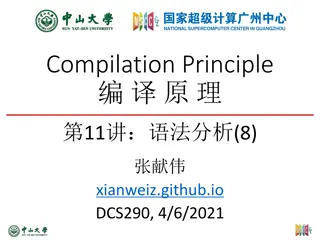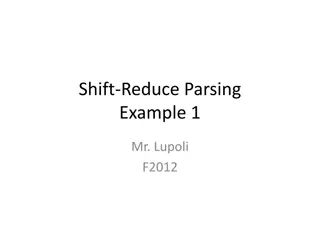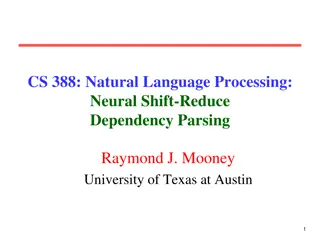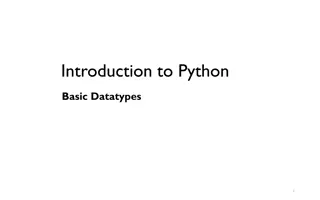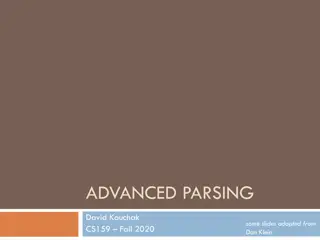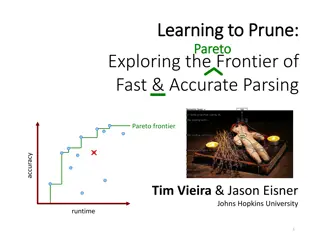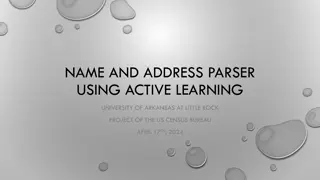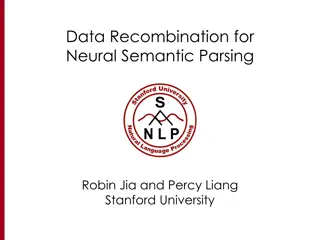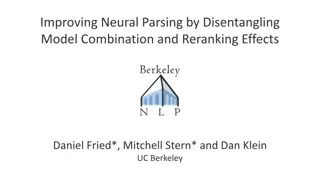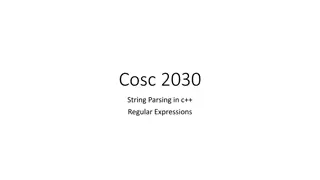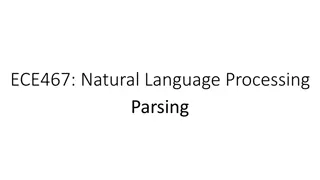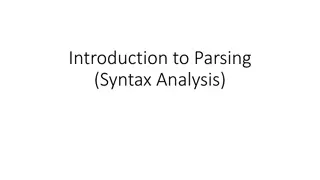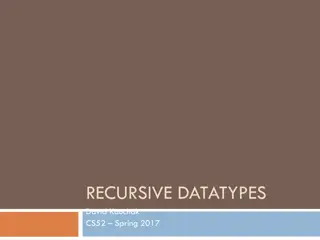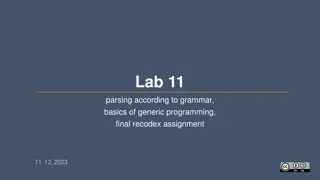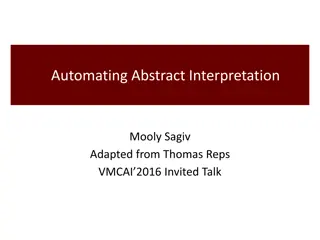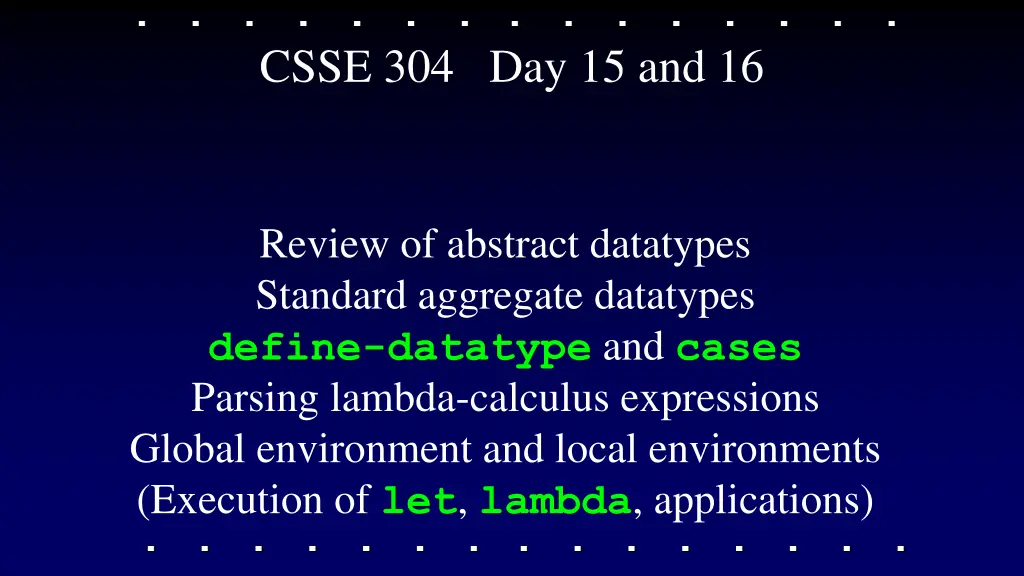
Review of Datatypes and Operations
Explore abstract datatypes, standard aggregate datatypes, define-datatype, and cases in the context of lambda calculus expressions. Learn about global and local environments, execution of let, lambda, and applications. Understand basic and derived operations, implementation strategies, arrays, records, and variant records. Discover the interpretation of data bits and datatype concepts. Delve into the interface, representation, and implementation of abstract datatypes.
Download Presentation

Please find below an Image/Link to download the presentation.
The content on the website is provided AS IS for your information and personal use only. It may not be sold, licensed, or shared on other websites without obtaining consent from the author. If you encounter any issues during the download, it is possible that the publisher has removed the file from their server.
You are allowed to download the files provided on this website for personal or commercial use, subject to the condition that they are used lawfully. All files are the property of their respective owners.
The content on the website is provided AS IS for your information and personal use only. It may not be sold, licensed, or shared on other websites without obtaining consent from the author.
E N D
Presentation Transcript
CSSE 304 Day 15 and 16 Review of abstract datatypes Standard aggregate datatypes define-datatype and cases Parsing lambda-calculus expressions Global environment and local environments (Execution of let, lambda, applications)
Definition Basic and derived operations Example: Non-negative integers Implementation strategies Standard Datatypes arrays and records Variant records EoPL's Scheme define-datatype Parsing lambda-calculus expressions DATATYPES
data bits interpretation
datatype What is an (abstract) data type? Interface (how the user sees it) Representation (data structure used) Implementation (provide the interface based on the representation) In EoPL notation, x means the current representation of x . Example: non-negative integers. n means the representation of the integer n.
Interface for "non-negative integer" datatype (zero) = 0 (iszero? n ) = #t if n is the representation of zero, #f otherwise. (succ n ) = n+1 ( n 0) (pred n+1 ) = n ( n 0) These operations define the datatype. Other operations can be derived from them. Derived op example (representation-independent code): (define add (lambda (m n) (if (iszero? n) m (add (succ m) (pred n)))))
Representation 1: Unary representation of non-negative integers 0 = ( ) ; the empty list n+1 = (cons #t n ) (zero) = 0 (iszero? n ) = #t if n is the representation of zero, #f otherwise. (succ n ) = n+1 ( n 0) (pred n+1 ) = n ( n 0) Define the integer operations. zero iszero? succ pred
Representation 1: Unary representation of non-negative integers 0 = ( ) ; the empty list n+1 = (cons #t n ) (zero) = 0 (iszero? n ) = #t if n is the representation of zero, #f otherwise. (succ n ) = n+1 ( n 0) (pred n+1 ) = n ( n 0) There is a (slightly) more efficient implementation of add (than the one from the non-negative-integer interface slide) if we base it on this representation instead of the ADT. Can you see what it is? That implementation is representation-dependent.
Other representations of non-negative integers There are several online only slides that present other possible representations of non-negative integers. The main point is that for any ADT specification, there can be many different representations/implementations.
Arrays Records (a.k.a. structs) Union Types Union types in Scheme viadefine-datatype AGGREGATE DATATYPES
Aggregate data types (arrays) An aggregate type can contain values of other types Most common aggregate type example: array Allocated consecutively Elements accessed by position (in constant time) In many languages (not Scheme vectors), an array must be homogeneous All elements of the array must be of the same type Is that true in Java?
Aggregate data types (records) Another aggregate type is the record type. This allows heterogeneous types for the elements, which are called fields Fields are accessed by name. In C, record types are called structs In Java, we create a new record type by declaring a ___________ The R6RS standard has define-record-type. We will instead use define-datatype, as in EoPL
Aggregate types (unions) Another aggregate type: union An element of a union type contains one type chosen from among several specified types (variants) Usually those variants are record types Typically, a union type includes a tag field that indicates which variant a particular datum belongs to. This is called a discriminated union type. C union types are indicated by the keyword ______________ . Pascal union types are called variant records In Java, we implement the union idea via _______________ . http://en.wikipedia.org/wiki/Union_(computer_science) Primarily a description of unions in C
DEFINING VARIANT RECORD DATATYPES IN SCHEME
define-datatype define-datatype is a way of adding variant record types to Scheme Provided by the authors of EoPL Implemented as a syntactic extension (using define-syntax). Instructions for getting set up to use define-datatype: Next slide.
Use define-datatype in your code Put chez-init.ss (linked from today's resources on schedule page) in the same folder as your code. Begin your code with (load "chez-init.ss") You ll need the full pathname if the chez-init.ss file is not in the folder where Scheme starts. When you upload to the PLC server, you do not need to upload the chez-init.ss file. The PLC server loads chez-init.ss automatically before it runs your code, and it ignores your (load "chez-init.ss")code.
Aside: Uploading multiple files to the server All files in the same folder on your computer One must be named main.ss Code in main.ss should load the other files (no pathnames) Make a .zip file containing all of your relevant .ss files Do not include any folders in your ZIP archive It is not necessary to include chez-init.ss in your ZIP file. Upload the ZIP file to the server.
Use a bintree datatype object (define-datatype bintree bintree? [leaf-node (datum number?)] [interior-node (key symbol?) (left bintree?) (right bintree?)]) This defines three procedures: constructors leaf-node and interior-node, and predicate bintree? >(define leaf-sum (lambda (tree) ; assume that tree is a bintree (cases bintree tree [leaf-node (datum) datum] [interior-node (key left right) (+ (leaf-sum left) (leaf-sum right))]))) cases is new syntax, defined in chez-init.ss (it is not the same as case)
Parse: from list to bintree Parsing the list form of a binary tree Given the list representation of a binary tree, produce a bintree datatype structure define-datatype automatically makes a constructor for each variant (define t2 (list->bintree '(a (b 1 2) (c (d 3 4) 5)))) >(define list->bintree (lambda (t) (cond [(number? t) (leaf-node t)] [(symbol? (car t)) (interior-node (car t) (list->bintree (cadr t)) (list->bintree (caddr t)))] [else (eopl:error 'list->bintree "improper data format")]))
bintree is an abstract data type The Chez Scheme implementation of ADTs defined by define-datatype happens to be lists. Makes debugging easier: Danger: you may be tempted to write representation-dependent code. Write representation-independent code. I.e., use cases, not car, cdr, etc. to get the fields of abintree.
define-datatype example Inorder traversal of interior nodes of a binary tree >(define inorder (lambda (tree) (cases bintree tree ; let's write it (define-datatype bintree bintree? [leaf-node (datum number?)] [interior-node (key symbol?) (left bintree?) (right bintree?)])
s-list datatype (for A11a) (define-datatype symbol-exp symbol-exp? [symbol-symbol-exp (data symbol?)] [s-list-symbol-exp (data s-list?)]) What does the type of list-of have to be? (define-datatype s-list s-list? [an-s-list (data (list-of symbol-exp?))]) (define list-of ; defined in chez-init.ss (lambda (pred) (lambda (val) (or (null? val) (and (pair? val) (pred (car val)) ((list-of pred) (cdr val)))))))
A datatype for -calculus expressions Parse a -calculus expression to produce an abstract syntax tree (AST)
Programs as data This is the beginning of the background for A11b. A program in any language really is data to be interpreted by Scheme makes the relationship more explicit. Same syntax for programs and data eval (which you are not allowed to use in your interpreter ) (let loop () (display "-->") (let* ([exp (read)] [val (eval exp)]) (pretty-print val) (loop))) Interpreter project solution not!
datatype for -calculus expressions (define-datatype expression expression? [var-exp (id symbol?)] [lambda-exp (id symbol?) (body expression?)] [app-exp (rator expression?) (rand expression?)]) I use slightly different names than the EoPL textbook, to be consistent with the homework documents and files. You will enhance this datatype to include other expressions (such as if, let, and multi-argument, multi-body lambda) Let's add set!, multiple rands. You'll add others in A11b
concrete vs. abstract syntax parser (app-exp (lambda-exp (x) ((if-exp (var-exp x) (var-exp y) (var-exp z)) (var-exp x)) ((app-exp (lambda-exp (y e) ((app-exp (var-exp +) ((var-exp e) (lit-exp 3))))) ((lit-exp 2))))) Two parens because a lambda- exp can have more than one body concrete syntax (parse-exp '((lambda (x) (if x y z) x) ((lambda (y e) (+ e 3)) 2))) abstract syntax
Parse lambda-calculus Expressions I.e., translate concrete syntax to abstract syntax (define parse-exp (lambda (datum) (cond [(symbol? datum) (var-exp datum)] [(pair? datum) (cond [(eqv? (car datum) 'lambda) (lambda-exp (caadr datum) (parse-exp (caddr datum)))] [else (app-exp (parse-exp (car datum)) (parse-exp (cadr datum)))])] [else (eopl:error 'parse-exp "Invalid concrete syntax ~s" datum)]))) Let's add set!. You'll add others in A11b You will add several other cases (if, let, etc.)
Using Parsed Lambda-Calculus Expressions (define unparse-exp (lambda (exp) (cases expression exp [var-exp (id) id] [lambda-exp (id body) (list 'lambda (list id) (unparse-exp body))] [app-exp (rator rand) (list (unparse-exp rator) (unparse-exp rand) )]))) Note that unparse-exp is simpler than parse-exp. Why?
About the parse problem in A11b Add additional features to the parseable language and modify the code for the basic features Add error checking. Important: To report an error: (eopl:error 'parse-exp "bad let*: ~s" exp) Figuring out all of the possible errors to check for is a major part of this assignment. Be sure to plan time for it. For team assignments, one team member should submit. Include other members usernames on the submission page. A11b is a team assignment. Do not do it alone. In order for the PLC server to recognize your error reports, you must use 'parse-exp as the first argument to eopl:error
How I will test your parse procedure 1. Test some cases that should return an error to make sure that your code actually detects the error (and reports it according to the previous slide) 2. Test-cases that call (unparse-exp (parse-exp 'some-legal-expression)) a. to see if your code returns the original expression 3. If you get zero points from the PLC server on either 1 or 2, you will also earn zero on the other part .
occurs-free? for parsed expressions (define occurs-free? (lambda (var exp) (cases expression exp [var-exp (id) (eqv? id var)] [lambda-exp (id body) (and (not (eqv? id var)) (occurs-free? var body))] [app-exp (rator rand) (or (occurs-free? var rator) (occurs-free? var rand))] )))
If there is time on Day 16. Otherwise I will postpone this until later. A brief look at LAMBDA-CALCULUS AND COMBINATORS
Computation in lambda calculus Key ideas: beta reduction alpha conversion eta reduction Number representation 0 := fx. x 1 := fx. fx 2 := fx. f (fx) 3 := fx. f (f (fx)) Operations SUCC := n f x. f (n f x) PLUS := m n f x. n f (m f x) MULT := mn. m (PLUS n) 0 AND := p q. p q p OR := p q. p p q NOT := p a b. p b a IFTHENELSE := p a b. p a b http://en.wikipedia.org/wiki /Lambda_calculus#Arithme tic_in_lambda_calculus http://safalra.com/science/la mbda-calculus/integer- arithmetic/
-calculus and Turing completeness The untyped lambda-calculus is Turing complete (meaning that we can compute anything with it that we can compute with any other accepted formal model of computation) http://en.wikipedia.org/wiki/Turing_complete ness This article may also be helpful: http://en.wikipedia.org/wiki/Lambda_calculus
Expressions with no free variables are called combinators (lambda (f g) (lambda (x) (f (g x)))) A famous combinator, Y, is the recursion maker . What is a good name for this combinator?
https://en.wikipedia.org/wiki/Fixed-point_combinator THE Y-COMBINATOR
Y-combinator ("recursion maker") (define Y (lambda (f) ((lambda (x) (f (lambda (t) ((x x) t)))) (lambda (x) (f (lambda (t) ((x x) t))))))) Note that while Y is unusual, there is nothing that looks recursive about it.
Y-combinator can be applied to (define H (lambda (g) (lambda (n) (if (zero? n) 1 (* n (g (- n 1))))))) (for example) Note that there is nothing recursive about H. We simply pass in g and possibly call it. But ... > ((Y H) 5) 120 In the pure lambda-calculus, in which parameters are passed "by name". the Y-combinator is slightly simpler. Note: This is the "applicative-order Y- combinator" which works in Scheme.
Y-combinator generates recursion without using define or other naming mechanisms
Syntax Semantics define-datatype and parse-exp give us a way to get from a concrete representation of program syntax to a more abstract one. Now we want to get the meaning (interpretation). How do we implement lexical scoping with first-class procedures? First question: How to represent the bindings of variables to data? (environments) We will spend a couple of class days taking an abstract look at this, then we will look at concrete implementations of environments
Some data structures behind Scheme's execution mechanism Many students have found this to be a difficult topic. We will spend about 2 class days (17 and 18) on it. Don't allow yourself to get lost during this discussion! Ask instead! ENVIRONMENTS AND CLOSURES
Variable bindings and environments An environment is a table of variable names (symbols) and their associated values. My environment pictures look like arrays, but of course environments can be implemented in other ways, including lists and hash tables. a #t xyz "xyz" i j 4 7
Variable bindings and environments The global (top-level) environment is dynamic; variables are added to the environment viadefine the values of variables are changed viaset! However car proc is represented car + However + proc is represented
Variable bindings and environments TSPL section 2.9 says: Variables must be defined before they can be assigned But in many Scheme versions (including Chez) , a set! of a previously undefined variable actually defines it. Thus at the top level, define and set! seem to be equivalent, although really they should be used for different things. Your interpreter will only be required to implement set! for defined variables.
local environments When a lambda-defined procedure is applied to arguments (also when a let, let*, or letrecis executed), a new local environment is created to hold the bindings of the variables that are defined at that level. . . .
Evaluate a let expression Evaluate (in the current environment) the expressions to get the values to be assigned to the let variables. Create a new local environment with bindings for the let variables. Its "enclosing environment" pointer points to the current environment. Evaluate the body of the let in this new environment. > (define a 5) > (let ([z (+ a 3)] [t 7]) (let ([y (+ z a)]) (list a t z y))) a. b. c. However car proc is represented car + a However + proc is represented 5
Procedures (closures) When a lambda-expression is evaluated, what is returned? When does the body of a lambda-expression get evaluated? What kind of info needs to be stored in a procedure? What happens when a procedure is applied? (Answers on the next few slides)
Procedures (closures) Whenever a lambda expression is evaluated, a procedure (also known as a closure) is created A closure consists of three parts. Note that a lambda expression is not a procedure. What is it? Is the body of a lambda expression ever evaluated during the evaluation of the lambda?
Procedure application I will draw pictures here and verbally describe what is going on. Much of that verbal explanation also appears in writing on the next two slides. You should read them later. 1. 2. The expressions for the procedure and arguments are evaluated. A new local environment is created: Each variable from the procedure's formal parameter list is bound to the corresponding value from the actual argument list. The new environment's "pointer to an enclosing environment" is set to be a copy of the local environment pointer that is the third part of the closure. The body of the procedure is evaluated, using this new local environment. If a variable is not found in local environment, look in the global environment. Simple Example: car + 3. > (define add2 (lambda (car) (+ car 2))) > (add2 17)

